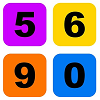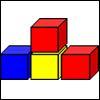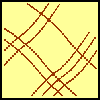NRICH was originally set up in 1996, meaning that 2016 brings our 20th birthday. To celebrate this occasion, we have brought together primary tasks, which may have previously gone unnoticed, in our Hidden Gems Feature. In this article, we will outline our reasons for choosing each task in the hope that we can entice you to try them with your own learners.
That Number Square is a great starting point as it could be used with children across a range of ages and experiences. The task is based on the premise that the numbers have all fallen off your class' hundred square and the challenge is to find a quick way of putting the numbers
back. We have included this task in our 'hidden gems' as it genuinely encourages children to think. They will draw on their knowledge of place value, multiples and times tables, as well as their understanding of pattern and possibly their visualising skills. The activity also offers an opportunity to discuss the ways of completing the square that the children use.
What is a good strategy for putting the number tiles back in the correct places as quickly as possible? What makes one strategy 'better' than another?
Animated Triangles offers a completely different mathematical context - properties of triangles, symmetry and rotation. Its accessible starting point means that it too could appeal to a wide range of learners. The stimulus for this task is a video, which will immediately
captivate children, and this is one of the reasons we have chosen to feature it. Watching the animation will produce rich conversations in which learners will grapple with mathematical concepts and appropriate language. Inviting them to create an image (or images) from the suggested two short sections of film gives them an element of choice and therefore more ownership of the task.
They might 'play safe' or decide to challenge themselves, but the key here is that they are showing you what they can do, not what they can't.
That Number Square! and Animated Triangles were both first published on NRICH some time ago, so perhaps you might not have come across them as we haven't featured them recently. By contrast, we wanted to draw your attention to our group of 'always, sometimes,
never' tasks because they have only just been published! There are four of this kind of activity in total. Each has the same format - a set of cards is given, upon which are written various mathematical statements and the aim of the task is to decide which statements are always true, which are sometimes true and which are never true. Always, Sometimes or Never?
KS1 includes two sets of cards, one focusing on number and one on shape. Always, Sometimes or Never? has a set of cards which is entirely linked with odd and even numbers, making it suitable for both upper and lower primary classes. Always, Sometimes or Never? Number and Always, Sometimes or Never?
Shape are both aimed at upper primary. All of the 'always, sometimes, never' tasks offer a great opportunity for learners to use reasoning to decipher mathematical statements. We often make mathematical claims that are only true in certain contexts and it is important for learners to be able to look critically at statements and understand in what situations they apply.
We have included Ice Cream as one of our 'hidden gems' as, although it does not fit neatly into the content of the curriculum in terms of number/calculation/geometry etc., it is a wonderful context in which to focus on problem-solving skills, reasoning and perseverance. In some ways, the
fact that the curriculum 'content' is minimal means that learners are 'freed up' to concentrate on the problem solving, which can be beneficial for many.
In Up and Down Staircases, learners are also identifying and explaining patterns. At first glance, it might look like a rather standard task in which children are invited to create the next arrangement in the sequence, then the next etc and to look for the pattern in order to generalise.
However, the reason for us including this task is that it involves a lovely example of a pattern which can be explained visually. It can be tempting in a task like this to focus only on the goal of expressing the pattern, rather than on being able to explain why the pattern occurs. This activity truly lends itself to understanding the reason behind the pattern.
Last, but by no means least in our primary Hidden Gems Feature, is Method in Multiplying Madness?. This task invites learners to watch videos of four different methods of multiplication and to make sense of each. There are several reasons for us wanting
to draw your attention to it: the opportunity to explore alternative calculation approaches; the simplicity of the videos (they include action but no sound); being able to spot 'same and different' in the approaches; and the way it inspires you to want to devise a similar set of clips for division!
In summary, we hope that you have been tempted to take a look at these 'hidden gems'. For more tasks that you may not have come across on NRICH before, see More Hidden Gems Lower Primary and More Hidden Gems Upper Primary. Do share your learners' responses to any of the tasks, either by encouraging them to submit a solution while the
tasks are live, or through Twitter: @nrichmaths. We look forward to hearing from you.
Here is a PDF version of this article.






